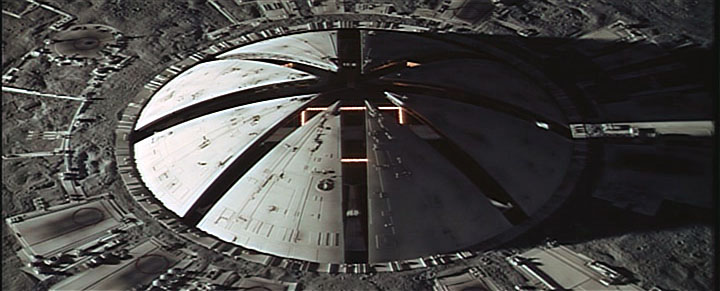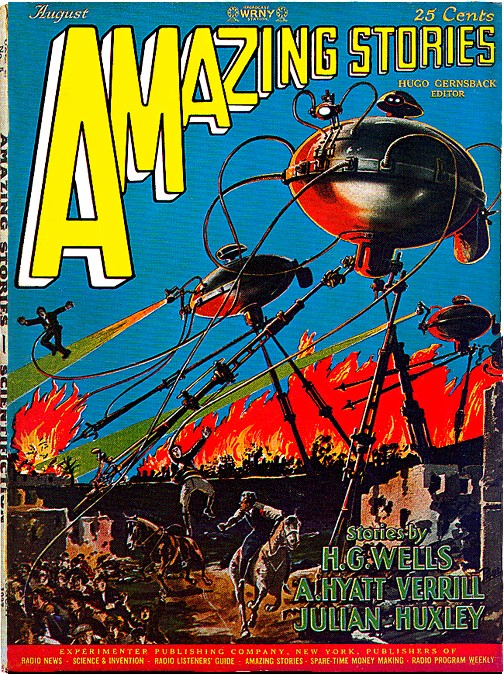Toward
a Genealogy of Cyberpunk
|
Lecture
outline: from traditional s/f to cyberpunk:
- the visual
style of 2001 and Blade Runner
- a dystopia
of instrumental control: "Alpha Ralpha Boulevard"
(1961)
- Gibson's
cure for s/f
- Characterize
the shift between traditional s/f to cyberpunk:
- Where
it happens (places and spaces)
- Hero's
character
- The
science and technology in the s/f
- 1984 novel,
Neuromancer: hero, cyberspace, action
|
|
The
aesthetic shift in science fiction
The leap from
traditional science fiction through Blade Runner to cyberpunk
entails an aesthetic shift from (the "Hilton" and "Clovis
Base" in 2001: A Space Odyssey) the modernist
austerity, purity and control of s/f utopias and dystropias
:


Sabastian's
apartment in Blade Runner: this thick dark place appears
as an uncontrolled hodge-podge of textures and styles, technology
and junk, machines, manikins, humans and replicants:

Critical
question: what lies behind this shift in aesthetic style
of s/f?
|
Traditional
science fiction's critique of instrumental rationality
Alpha Ralpha
Boulevard (1961), Cordwainer Smith
Overview:
Paul and Virginia are humans freed from the full control
by the Instrumentality: they are given a historical culture,
language, the ability to die at any time. However, because
of an old prediction, Virginia has doubts about whether
they are really acting on their own feelings and
thoughts. With the help of Macht, they go on a pilgrimage,
along the forbidden zone of Alpha Ralpha Boudevard, to find
the answer through an old machine/ computer, named the Abba-dingo.
Features of
this sort of dystopian narrative
- Non-human
or super-humans control this world completely; here utopia
= dystopia
- Those
who are inside this world don't know they are in it
- Humans
become much less then human; they are mere objects of
control
- Something
causes a "break in control"
- Heroic
investigation of the limits of control requires going
to the physical boundary
- Action:
the "run" to the edge of the world
|
Addicted
to the Future: Gibson's rehab program
Gibson, "The
Gernsback Continuum"
- Narrator
as photographer for The Airstream Futuropolis: the
Tomorrow That Never Was
- "Elaborate
props for playing at living in the future"(458)
- Images
of the future: the cover-art of Frank R. Paul
- Space
ships
- Cityscapes
and Wright's Johnson's Wax Building
- Drugs and
a vision, 463-465
- Base reality
as antidote to dystopian utopia
Question:
does Star Wars II: the Attack of the Clones take
us into the Gernsback continuum?
|
From
traditional science fiction to cyberpunk
Place where
it happens
- Clean well-lighted
sythetic spaces
- Uncontrolled,
layered, dirty
- Paradox:
the dystopian as a site of freedom
- Final frontier:
from outerspace to cyberspace
Hero through
whom we follow through the action
- Scientist:
upright, rational, serious, doing "good" for
humankind
- Detective
of film noir: alienated, cynical, "castrated"
- Hacker:
an outlaw, a drifter, and 'tripping'
Science changes
- From grand
stategy to bottom up tactics
- From hard
science (of rockets, nuclear reactors, etc.) to the soft
sciences of software and bio-engineering
- Humans
are more embedded in techno- science
|
|
| Bruce
Sterling summarizing the 'new' science of/in cyberpunk
|
| "Technical
culture has gotten out of hand. The advances of the
sciences are so deeply radical, so disturbing, upsetting,
and revolutionary that they can no longer be contained.
They are surging into culture at large; they are invasive;
they are everywhere. The traditional power structure,
the traditional institutions have lost control of the
pace of change....Times have changed since the comfortable
era of Hugo Gernsback, when Science was safely enshrined
-- and confined -- in an ivory tower. The careless technophilia
of those days belongs to a vanished, sluggish era, when
authority still had a comfortable margin of control.
For the cyberpunks, by stark contrast, technology is
visceral. It is not the bottled genie of remote Big
Science boffins; it is pervasive, utterly intimate.
Not outside us, but next to us. Under our skin; often,
inside our minds." (Introduction to Mirrorshades:
the cyberpunk Anthology xii-xiii) |
|
| William
Gibson, Neuromancer |
|
The
down on his luck, hacker hero named Case
"I saw
your girl last night," Ratz said, passing Case his
second Kirin. "I don't have one," he said, and drank.
"Miss Linda Lee." Case shook his head. "No girl? Nothing?
Only biz, friend artiste? Dedication to commerce?"
The bartender's small brown eyes were nested deep
in wrinkled flesh. "I think I liked you better, with
her. You laughed more. Now, some night, you get maybe
too artistic, you wind up in the clinic tanks, spare
parts." "You're breaking my heart, Ratz." He finished
his beer, paid and left, high narrow shoulders hunched
beneath the rain-stained khaki nylon of his windbreaker.
Threading his way through the Ninsei crowds, he could
smell his own stale sweat. Case was twenty-four. At
twenty-two, he'd been a cowboy a rustler, one of the
best in the Sprawl. He'd been trained by the best,
by McCoy Pauley and Bobby Quine, legends in the biz.
He'd operated on an almost permanent adrenaline high,
a byproduct of youth and proficiency, jacked into
a custom cyberspace deck that projected his disembodied
consciousness into the consensual hallucination that
was the matrix. A thief he'd worked for other, wealthier
thieves, employers who provided the exotic software
required to penetrate the bright walls of corporate
systems, opening windows into rich fields of data.
He'd made the classic mistake, the one he'd sworn
he'd never make. He stole from his employers. (Neuromancer,
5)
|
|
Conceptualizing
cyberspace as a locus of adventure
"The
matrix has its roots in primitive arcade games," said
the voice-over, "in early graphics programs and military
experimentation with cranial jacks." On the Sony,
a two-dimensional space war faded behind a forest
of mathematically generated ferns, demonstrating the
spatial possibilities of logarithmic spirals- cold
blue military footage burned through, lab animals
wired into test systems, helmets feeding into fire
control circuits of tanks and war planes. "Cyberspace.
A consensual hallucination experienced daily by billions
of legitimate operators, in every nation, by children
being taught mathematical concepts . . . A graphic
representation of data abstracted from the banks of
every computer in the human system. Unthinkable complexity.
Lines of light ranged in the non space of the mind,
clusters and constellations of data. Like city lights,
receding...." (51)
|
|
Jacking
in and getting "off" in cyberspace
"Please,
he prayed, now-- A gray disk, the color of Chiba sky.Now--
Disk beginning to rotate, faster, becoming a sphere
of paler gray. Expanding-- And flowed, flowered for
him, fluid neon origami trick, the unfolding of his
distance less home, his country, transparent 3D chessboard
extending to infinity. Inner eye opening to the stepped
scarlet pyramid of the Eastern Seaboard Fission Authority
burning beyond the green cubes of Mitsubishi Bank
of America, and high and very far away he saw the
spiral arms of military systems, forever beyond his
reach. And somewhere he was laughing, in a white-painted
loft, distant fingers caressing the deck, tears of
release streaking his face. Molly was gone when he
took the trodes off, and the loft was dark. He checked
the time. He'd been in cyberspace for five hours."
(52)
|
|
|
Assignment
for Thursday, May 23rd:
Read
and outline two short stories from the same Sprawl
series as Neuromancer and a short story that uses
the cyberpunk formula from the vantage point of a
female hacker:
Gibson, "Johnny Mnemonic" (1981)
Gibson, "Burning Chrome" (1985)
Dorsey, "(Learning About) Machine Sex",
746-761
|
|
|
|






